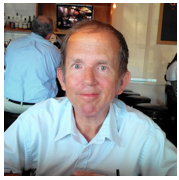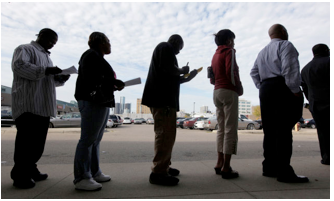WHO WE ARE-Washington greeted the latest jobs numbers with enthusiasm. In September, the unemployment rate fell below six percent for the first time since July, 2008. We’ve netted 2.64 million jobs over the past 12 months, and are on pace to add more jobs in 2014 than in any year since 1999.
But today, five years after the economy officially went into “recovery,” three million people remain among the ranks of the long-term unemployed — jobless for 27 weeks or more. That number is down from its 2010 peak, but as the Economic Policy Institute’s David Cooper noted earlier this year, it still “far exceeds pre-Great Recession levels in virtually every state.”
About a million Americans have been unemployed for two years or longer, and approximately 100,000 have been jobless for at least five years.
These are the forgotten victims of the economic meltdown triggered by the crash of Wall Street’s grand casino.
Their unemployment benefits exhausted, they live for as long as possible on whatever savings they may have accumulated. And then they turn to the underground economy, which Edgar Feige, an economist at the University of Wisconsin-Madison, estimated to have grown to $2 trillion by 2012.
They scrounge and scrape to get by. Some turn to crime.
Los Angeles Times reporter Don Lee recently profiled one of these abandoned workers — a man whose story is typical of many of the long-term unemployed.
 It has come down to this for Brian Perry: an apple or banana for lunch, Red Sox ballgames on an old Zenith TV and long walks to shake off the blues.
It has come down to this for Brian Perry: an apple or banana for lunch, Red Sox ballgames on an old Zenith TV and long walks to shake off the blues.
At 57, Perry (photo left) has been unemployed and looking for work for nearly seven years, ever since that winter when the Great Recession hit and he was laid off from his job as a law firm clerk.
By his count, Perry has applied for more than 1,300 openings and has had some 30 interviews, the last one a good two years ago. With his savings running dry, this summer he put up for sale his one asset — a three-bedroom house his parents used to own in this suburb of Providence.
“I’m not looking for pity, just one last opportunity,” said Perry, a boyish-looking man with bright blue eyes and a nasal New England brogue …
Perry said his long unemployment continues to be seen by some employers as a big black mark on his forehead.
Perry became depressed. He started eating tons of junk food and stopped going to the gym. He put on weight, and eventually developed a heart condition that required surgery.
His experience isn’t unique. As The Fiscal Times reported earlier this year, a 2011 study of the long-term unemployed by Rutgers University’s John J. Heldrich Center for Workforce Development “found that the vast majority of unemployed workers experienced stress in their relationships with family and friends and that at least 11 percent reported seeking professional help for their depression within the previous 12 months.”
Half of them reported that “they began avoiding friends and associates out of a sense of shame and embarrassment — a self-imposed isolation that hurt their ability to network to find work.” One researcher toldThe Fiscal Times that the effects of long-term unemployment represent “a silent mental health epidemic.”
 Even with the falling jobless rate, there are still two people seeking work for every open position. And while finding a job can be hard for everyone, Mark Price, a labor economist at the Pennsylvania-based Keystone Research Center, tells BillMoyers.com that those who have been out of the labor market for long periods of time face unique challenges getting back in.
Even with the falling jobless rate, there are still two people seeking work for every open position. And while finding a job can be hard for everyone, Mark Price, a labor economist at the Pennsylvania-based Keystone Research Center, tells BillMoyers.com that those who have been out of the labor market for long periods of time face unique challenges getting back in.
“The biggest is bias on the part of employers against workers with long gaps in their work history,” says Price. “In the inevitable sorting that employers do of job applications, a worker with a long spell of unemployment is frequently excluded from further consideration regardless of their skill and work experience.”
It’s an observation that’s borne out by empirical studies. And that discrimination creates a vicious cycle, causing job seekers to give up hope and drop out of the labor market entirely.
Tragically, many of those who do manage to return to the workforce don’t remain in it for long. Their skills are rusty, or they may have grown unaccustomed to working within a hierarchical organization.
A study released earlier this year by Princeton University economists Alan Krueger, Judd Cramer and David Cho found that 15 months after returning to work, the number of long-term unemployed who left the workforce again was twice as high as those who had settled into full-time employment.
And for those fortunate enough to find work and keep it, many have taken a huge financial hit — losing 40 percent or more of their pre-recession incomes, according to The Urban Institute.
{module [862]}
{module [662]}
It doesn’t have to be this way. An innovative program in Connecticut called Platform to Employment takes a multi-pronged approach to helping these workers ease back into the groove. The program offers intensive training, with mock job interviews, mental health services to combat depression and anxiety, and then places them in eight-week internships — with the first four weeks paid in full by Platform to Employment, and the last four weeks split 50/50 between the employer and the nonprofit.
The program boasts a 90 percent success rate, but so far has received only a few million in state funding.
And while three million people face the intense pain of long-term joblessness, the issue doesn’t even appear to be on Congress’s radar.
(Joshua Holland is Senior Digital Producer at BillMoyers.com, and host of Politics and Reality Radio. He's the author of The 15 Biggest Lies About the Economy. This piece was posted first at BillMoyers.com)
-cw
CityWatch
Vol 12 Issue 82
Pub: Oct 10, 2014




